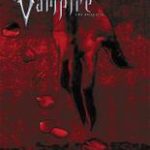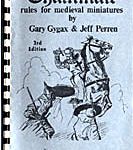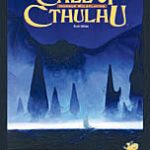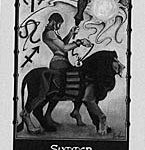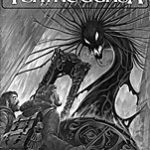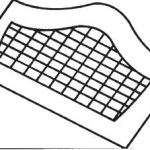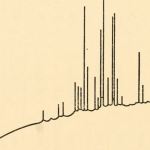2008
Will Hindmarch contests Greg Costikyan's challenge to the idea that "games have something to do with stories" by contending that "storytelling games reconcile the theoretically antithetical relationship between their two halves - story and game."
2007
Greg Costikyan revisits the narrative versus game-play debate that continues to be a staple of both Game Studies and Game Design. He presents a spectrum that ranges from game-focused forms to narrative-centric models, and suggests that free-form role-playing may be the most desireable marriage of narrative and game-play.
Erik Mona takes a first step toward measuring the cultural impact of Gygax and Arneson's Dungeons & Dragons by providing a pocket history of the game's generation and evolution. Mona explains the addition of character development as a game goal - the innovation that distinguishes D&D from its predecessors, and started the role-playing revolution.
Kenneth Hite argues that the long-running, H.P. Lovecraft-inspired Call of Cthulhu franchise differs from traditional tabletop role-playing in its focus on suspense rather than character growth. Hite's analysis suggests that in its origins and emphasis on narrative structure Cthulhu is a highly literary game.
Van Leavenworth, in his response to Hite, delves more deeply into Cthulhu's literariness, in particular the "large adventure book 'footprint'" of the series. He contends that the Lovecraft mythos provides a framework for the generation of narratives that - unlike many RPG stories - hold up beyond the game-play session.
David Alger responds to Herber by disagreeing with the latter's claim that narrative trumps game-play in the Cthulhu "Haunted House" scenario, stressing that even the most narratively driven games still must be playable in order to be games.
Jonathan Tweet explains how, unlike highly narratively structured games such as The Call of Cthulhu, the free-form, character-focused Everway includes a matrix that allows for the creation of coherent characters and productively constrains the otherwise open-ended game-play.
Keith Herber discusses how in his "Haunted House" scenario for Call of Cthulhu, characters are driven insane by their attempt to unravel the game's mysteries. Herber's explanation distinguishes his work from many other role-playing games in which the goal is to develop characters and acquire power and/or wealth. In contrast, characters in Herber's scenario are rewarded with mental instability.
Lori Emerson introduces a gathering of nineteen electro-poetic essays. This gathering brings together both critics and creators of electronic poetry; as is usually the case in ebr, the 'electronic' does not exclude, but helps us to reconfigure and revalue poetic works in print as well as define what works in digital environments.
Eugene Thacker resituates the work of Eduardo Kac, not as art applied to the life sciences, but as a form of bio-poetics, consistent with the electro-poetics that has been a longtime focus of critical writing in ebr. Rather than reduce the work to its material (in life-forms, or in text, or in code), Thacker identifies ways that language, form, and life intersect in works of bio-art.
Rowan Wilken sets himself the challenge of theorizing the unrepresentable in relation to the architectural model of the diagram.
As I thread my way through ebr, I touch base with the artificial intelligentsia that my work circulates in. The artificial intelligentsia is an internetworked intelligence that consists of all the linked data being distributed in cyberspace at any given time, one that is powered by artistic- intellectual agents remixing the flow of contemporary thought.
Jerome McGann addresses the so-called "Crisis in the Humanities" in the context of two of its most apparent symptoms: the digital transformation of our museums and archives, and the explicitly parallel "Crisis in Tenure and Publishing" that has more recently come to attention.
2006
Entering the 'cyberdebates' initiated by Nick Montfort, John Cayley, and Rita Raley, new media scholar Mark Marino proposes that we should analyze and explicate code as a text like any other, 'a sign system with its own rhetoric' and cultural embeddedness.
Joseph Tabbi introduces the thread and gathers prior essays by fiction writers on fiction writing.
Rob Swigart asks why we keep hearing about a technological fix (dubious) and rarely about adaptation as a viable response to global warming.
This review of Ralph Berry's novel Frank and the subsequent exchange between the authors, appeared in the March/April 2006 and July/August 2006 issues of The American Book Review.
2005
Jokes play a fundamental role in Slavoj Žižek's philosophizing. Is Žižek joking when he extols the virtues of Christianity to the Left? Eric Dean Rasmussen analyzes Žižek's pro-Christian proselytizing as attacks on modes of PC-ness - political correctness and perverse Christianity - that sustain an undesirable neoliberalism.
1999 e-literature award winner John Cayley writes about Saul Bass of classic film title fame. A precursor to language arts innovators Jenny Holzer, Richard Kostelanetz, and Cayley himself, Bass may now be recognized as a poet in his own 'write,' important for a new generation of designwriters creating "graphic bodies of language," moving words and signifying images, in digital environments.
